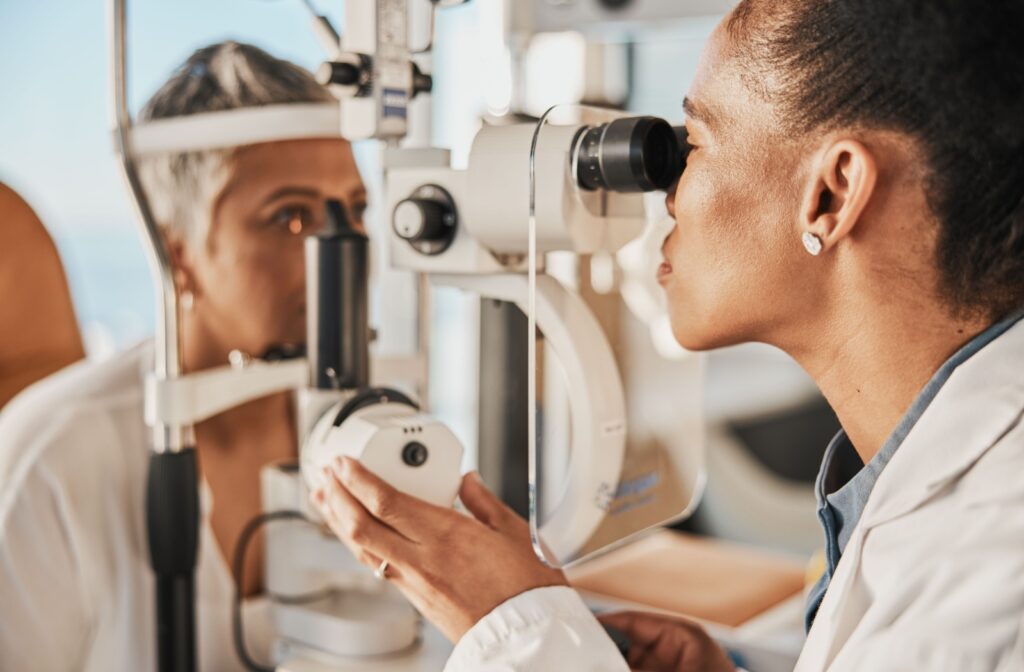When you think about an eye exam, you might picture a routine vision check to see if you need glasses or contact lenses. However, comprehensive eye exams reveal much more than vision issues; they provide insights into your overall health, including early diabetes signs.
Eye doctors can detect changes in the blood vessels in the retina, a part of the eye that often shows early signs of diabetes-related complications. Changes in the eyes can appear before noticeable symptoms, making regular eye exams a crucial step in early detection and prevention.
For people living with diabetes, specialized diabetic eye exams help manage this leading cause of blindness in adults.
The Link Between Eye Health & Overall Health
Your eyes aren’t just a window to your vision—they can also provide valuable clues about your overall health. The tiny blood vessels in the retina are sensitive to changes in blood sugar levels, making them an early indicator of conditions like diabetes.
Many systemic diseases, including diabetes, can first appear in the eyes before affecting other parts of the body. This is why routine eye exams are about more than just vision correction—they serve as critical health check-ups.
What Is Diabetes & How Does It Affect the Eyes?
Diabetes is a chronic condition that affects the body’s ability to regulate blood sugar levels.
When the body either does not produce enough insulin or cannot effectively use the insulin it makes, blood sugar levels rise, leading to potential complications throughout the body—including the eyes.
How Diabetes Impacts Vision
High blood sugar levels can damage the delicate blood vessels in the retina, leading to various eye conditions:
- Diabetic retinopathy occurs when high blood sugar damages the blood vessels in the retina, potentially causing leakage, swelling, or abnormal blood vessel growth, leading to vision loss
- Macular edema develops when fluid builds up in the macula, the part of the retina responsible for sharp central vision, resulting in blurry or distorted vision
- Glaucoma can arise when pressure increases inside the eye due to diabetes-related complications, damaging the optic nerve & leading to peripheral vision loss or blindness
- Cataracts, the clouding of the eye’s natural lens, can cause blurry vision and increased sensitivity to light
Signs of Diabetic Eye Disease
Diabetic eye disease often develops without early warning signs, making routine eye exams crucial for detecting changes in your eye health. However, as the condition progresses, symptoms may include:
- Blurry or fluctuating vision
- Sudden vision loss
- Frequent prescription changes
- Dark spots or floaters
- Increased light sensitivity
Early recognition of these symptoms can allow for timely intervention to help prevent permanent vision loss.
Can Regular Eye Exams Detect Signs of Diabetes?
A comprehensive eye exam can detect early signs of diabetes by examining the retina and blood vessels. These exams help eye doctors identify tiny hemorrhages, fluid leakage, or changes in blood vessel structure—all of which can indicate potential complications from diabetes.
During an eye exam, your optometrist may notice:
- Retinal bleeding or swelling, suggesting early diabetic changes
- Narrowed or damaged blood vessels, indicating poor circulation due to high blood sugar
- Unusual deposits in the retina, signaling potential eye health issues linked to diabetes
If your eye doctor suspects diabetes, they may refer you to a primary care physician for further testing and diagnosis.

What Is a Diabetic Eye Exam?
For individuals with diabetes or those at high risk, we recommend a diabetic eye exam annually to monitor for signs of diabetic eye disease. Unlike a standard eye check-up, this exam includes specific tests to detect and monitor early complications.
Tests Performed During a Diabetic Eye Exam
Your eye doctor will complete various evaluations that may include:
- Dilation eye drops enlarge the pupils to allow a clearer view of the retina & optic nerve for signs of damage
- Retinal imaging captures detailed images of the retina & supports early detection of diabetic retinopathy
- Optical coherence tomography (OCT), a noninvasive scan, provides cross-sectional images of the retina, helping to detect swelling or fluid buildup in the macula
Even if a person doesn’t have noticeable symptoms, a diabetic eye exam can reveal early changes, making earlier treatment possible.
Preventing Diabetic Eye Complications
Whether you have diabetes or not, taking proactive steps can help protect your vision and overall health. There are several ways you can help reduce the risk of developing diabetic eye disease:
- Schedule regular eye exams
- Annual exams help detect changes before they impact vision
- Manage blood sugar levels
- Keeping blood sugar within a healthy range helps protect blood vessels in the retina
- Maintain a healthy lifestyle
- Regular exercise, a balanced diet, & weight management can help prevent or control diabetes
- Quit smoking
- Smoking can increase the risk of diabetic retinopathy & other vision problems
- Monitor your eye health
- If you notice sudden vision changes, seek medical attention promptly
Consistently following these preventive measures can reduce the risk of diabetic complications and support long-term eye health.
Prioritize Your Vision with Bluebird Vision + Wellness
Routine eye exams do more than check for blurry vision—they can also detect serious health issues like diabetes before noticeable symptoms appear. Regular eye exams can help monitor changes and prevent vision loss if you’re at risk for or have been diagnosed with diabetes.
At Bluebird Vision + Wellness, we provide comprehensive diabetic eye exams to help detect early signs of eye disease and protect long-term vision. Schedule an appointment today to take proactive steps toward achieving clear, healthy vision.




